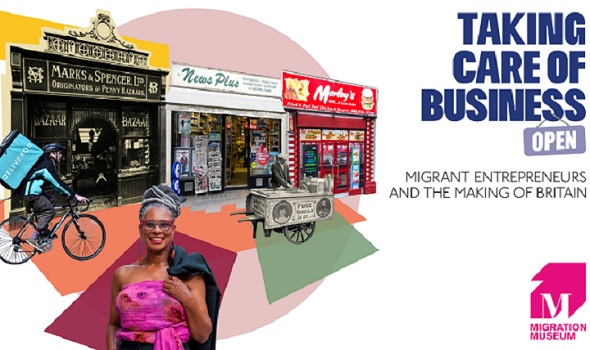Migrants mean business, as the new exhibition at the Migration Museum shows
Migrants mean business, as the new exhibition at the Migration Museum shows

Taking Care of Business: Migrant Entrepreneurs and the Making of Britain has good stories to tell, from Jimmy Choo to easyJet, from Madame Tussauds to the man behind the James Bond films.
It starts, of course, with takeaways and cafes and home-made food, because that’s how many migrant businesses have taken their first steps.
An exhibition caption quotes Spasia Dinkorski’s recollection: “I would wake up, make myself a coffee and then start baking borek [a flaky pastry that can have a variety of fillings]… I would then load up my pink trolleys with pies and take them on the tube to make deliveries.”
Some enterprises fail because they are ahead of their time - like Dean Mahomed’s first curry house in 1810. Undeterred, he set up Mahamed’s Baths in Brighton (and later became “shampooing surgeon” to two British kings).
The first Indian restaurants in London’s West End - mostly employing ex-Bangladeshi seamen as chefs - catered for well-to-do Indian students and Britons returning from postings in the British Raj.
The Bangladeshi-owned cafes in London’s Brick Lane (“Banglatown”) targeted Asian working men, until Pakistan-born Musa Patel changed everything with The Clifton in 1967.
The first Cantonese restaurant, Maxim’s, in Soho opened in 1908, but the exhibition tells us that the Chinese restaurant and takeaway phenomena didn’t take off until 1958.
Indran Selvendran from Sri Lanka opened a chicken shop in Sydenham in 1985, spawning a family-run south London chain and scores of rip-off versions, many copying its red-and-white colours.
The first coffee house, we are told, was established by an Armenian trader in 1652 and 300 years later it was Italian migrants who brought us coffee bars - including the biggest chain, Costa, to the point where we as a nation drink 100 million coffees a day.
Survival was a key motivating force in this food revolution that has transformed and enriched Britain. Angela Hui, who grew up in a Chinese takeaway in south Wales - and is among those whose studies and memories make this show so entertaining- says that “takeaways were underpinned by colonialism, and British Chinese food developed under a determination for a better life despite the struggles faced.
“Sweet and sour pork and chop suey weren’t just delicious; they also tell stories of waves of immigration from Hong Kong, China, Vietnam and Malaysia.”
Not all migrant enterprises survive. The exhibition has a powerful photograph of an anti-German riot outside the shop of a naturalised German immigrant, Fred Sieber, who was part of a number of migrant butchers from the small Hohenlohe region who experienced a backlash during the First World War. Many were interned or shipped back to Germany. The indiscriminate nature of xenophobia, and all forms of discrimination, was underlined by the fact that at the time of the riot Sieber had become a British national and his eldest son was a British officer fighting the Germans.
That was (and is) not the only problem for entrepreneurial migrants. Examples in the exhibition include Smokey Joe’s Diner, whose Jamaican owner couldn’t get a bank loan to expand his highly popular enterprise. “The bank told me it wouldn’t last more than two-and-a-half years.” It lasted nearly 12 before he retired.
Foreign-sounding names were often changed to make them easier for language-lazy Brits, though for Dame Stephanie Shirley, who escaped from Germany as a child in the late 1930s, the problem was not xenophobia but misogyny. Business letters on behalf of her “company of women managed by women” got zero response “until my dear husband suggested that I use the family nickname of Steve [and] things began to take off. I’ve been Steve ever since.”
Others faced racism (like the “corner shop families” who introduced open-all-hours culture to Britain and found the police unwilling to take an interest in the harassment they faced) or just general dinginess: “When I first arrived it was difficult,” a Sri Lankan is quoted as saying. “It was gloomy and dark, I struggled with the language and my studies, and I wanted to go back home.” Dinusha Dissanayake persevered and now has five cafes in south London
The exhibition also features success stories in other areas, such as the Tech Zone, music, hairdressers (including Britain’s first multimillion pound Black-owned business), and boutiques (where visitors are reminded that some “migrant garment-factory owners have been found guilty of exploiting migrant workers”).
The museum has tried to be bold and creative: baked bean cans that speak in the Corner Shop section, fascinating old photos, original art. But some sections look rushed, even unfinished, and do not provide enough information. The result is patchy and a bit rough-and-ready.
In the promised land, when the Migration Museum is properly funded and has a permanent home, it should revisit and expand this exhibition to prove the enormous contribution made to Britain by migrant entrepreneurs. In the meantime, this is a good start.
* Taking Care of Business: Migrant Entrepreneurs and the Making of Britain is at the Migration Museum, Lewisham Shopping Centre (entrance in Central Square), London SE13, Wednesday to Sunday, until 5 March 2023. Info: [email protected]


